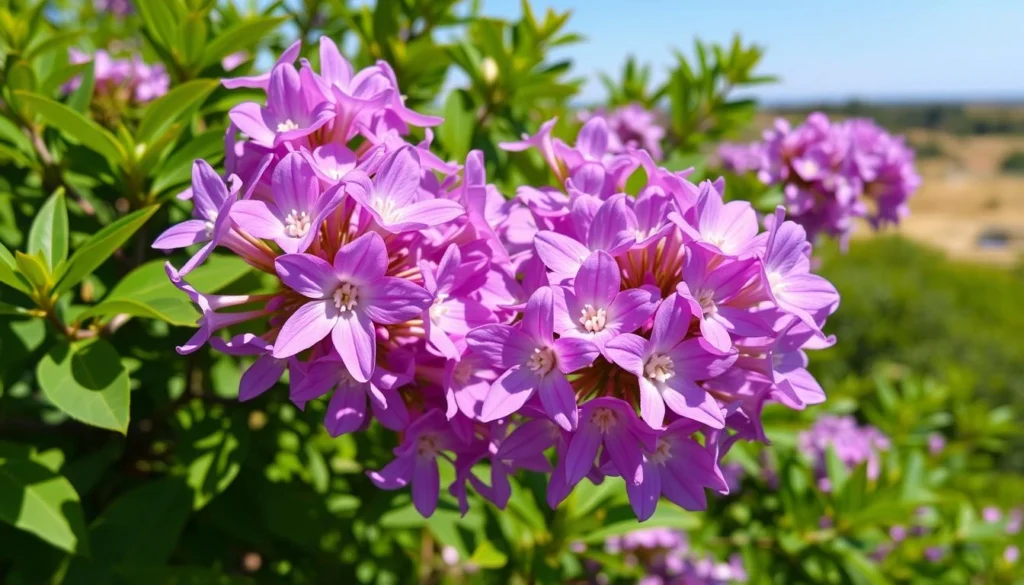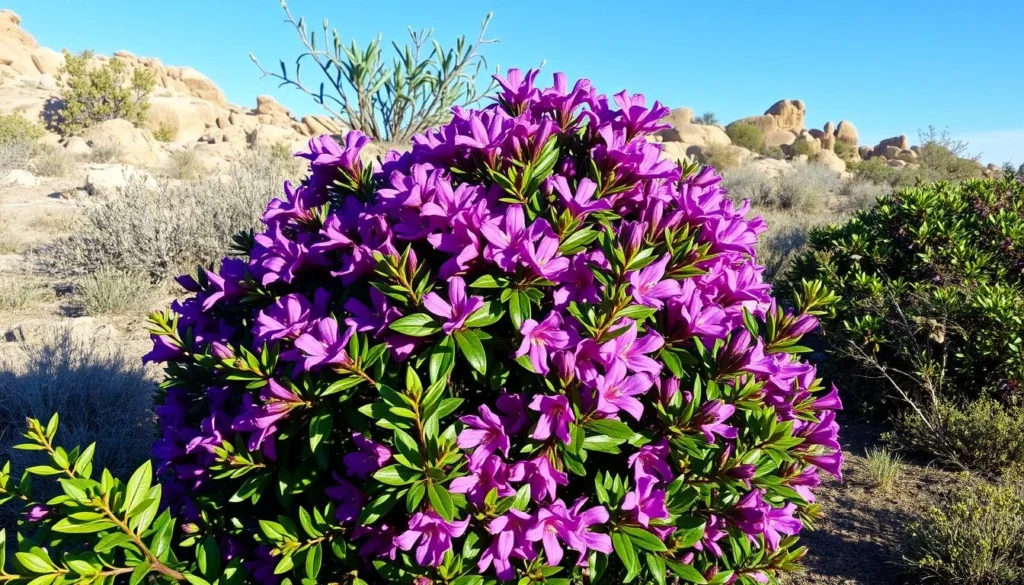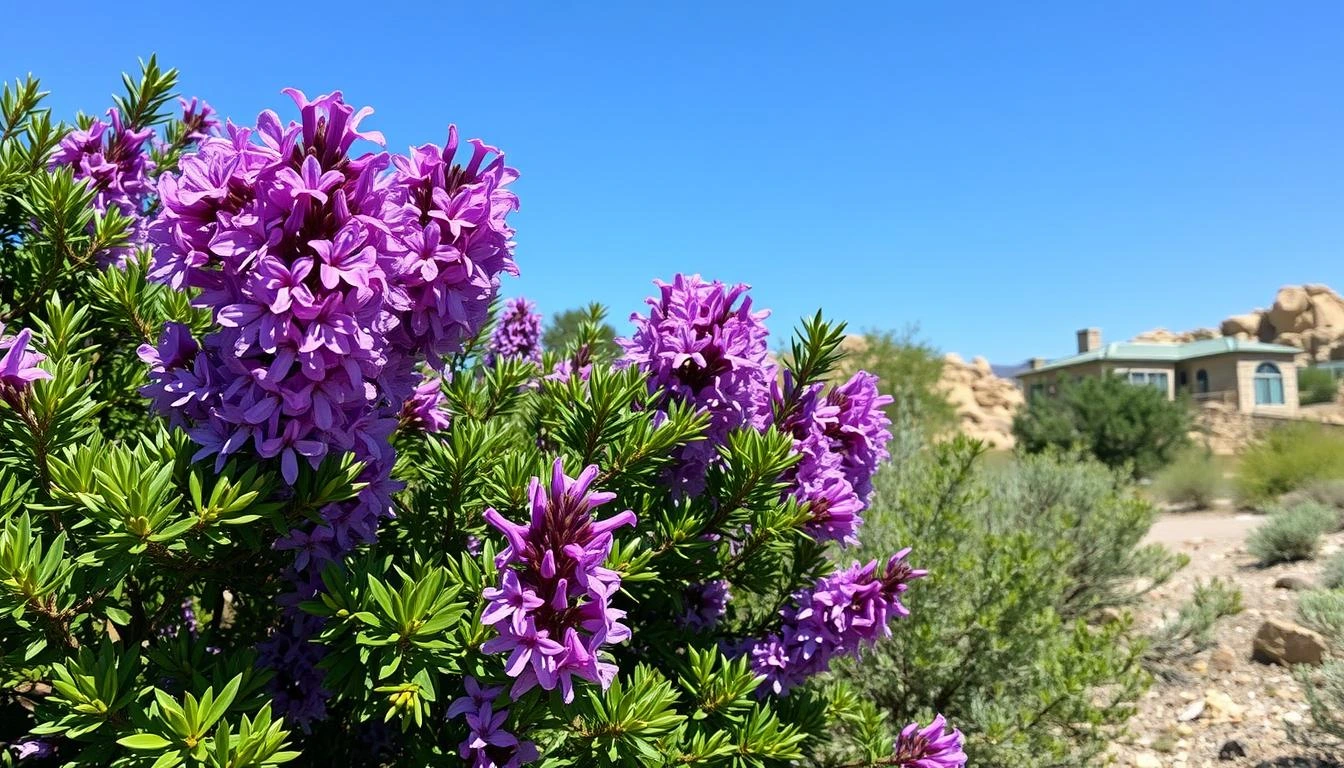As a native Texan, I’ve always been amazed by our state’s natural wonders. The Texas mountain laurel is one such marvel. It’s a shrub that has won the hearts of many in Texas. Its vibrant purple flowers and lush, evergreen leaves show the beauty and strength of our native plants.
Seeing a Texas mountain laurel in bloom is a breathtaking sight. Whether you’re in a botanical garden or your own backyard, it’s a sight to behold. This shrub’s sweet scent and whimsical flowers take you to a world of wonder and peace.
Table of Contents
Understanding Texas Mountain Laurel: A Native Beauty
The texas mountain-laurel is a stunning native shrub found in Central and West Texas. It has distinctive leathery leaves and fragrant purple flowers that bloom in the spring. These flowers captivate everyone who sees them.
Natural Habitat and Distribution
The mountain laurel is a true Texan, mainly found in the Hill Country and Trans-Pecos areas. It loves well-drained soils and partial shade. This makes it perfect for the rocky, wooded landscapes of these regions.
While not as common as other native plants, the texas mountain-laurel is a cherished sight. It’s a treat for those who get to see it in its natural setting.
Physical Characteristics
The mountain-laurel is easy to spot because of its unique foliage. It has leathery, evergreen leaves that are a deep, rich green. In the spring, it blooms with clusters of fragrant, purple flowers that look like delicate butterflies.
After the flowers fade, the plant shows off attractive seed pods. These pods add interest all year round.
Growth Pattern and Mature Size
The texas mountain laurel grows slowly and can reach 10 to 15 feet tall and wide. It has a multi-trunked growth pattern, making it look like a shrub. While it takes time to grow, the mountain laurel is worth the wait.
It offers beauty all year and gives a true taste of Texas. It’s a gem for any garden.
The History and Cultural Significance of Mountain Laurel in Texas
The texas mountain-laurel holds a special spot in Texas. It’s a native shrub that has been part of the state’s natural beauty for centuries. It’s deeply rooted in Texas culture.
Indigenous peoples like the Comanche and Apache tribes valued the mountain laurel tree. They used its purple flowers in ceremonies, showing the beauty and strength of Texas.
“The mountain laurel is not just a plant, but a testament to the enduring spirit of Texas.”
When European settlers came, they saw the texas mountain laurel’s beauty. They added it to their gardens, making it a staple in Texas homes and public areas.
Now, the mountain laurel tree is a symbol of Texas pride. It’s found in parks, gardens, and homes, loved for its beauty and cultural importance.
The texas mountain-laurel has a deep history in Texas. It inspires Texans today, reminding us of our natural heritage and our bond with the land.
Essential Growing Requirements for Texas Mountain Laurel
Adding the stunning Texas mountain-laurel to your garden is exciting. But, knowing its specific growing needs is key. This native Texas shrub needs the right soil, sunlight, and water. By meeting these needs, your care will pay off, and you’ll enjoy its blooms for years.
Soil Type and pH Requirements
The Texas mountain-laurel loves well-drained, slightly acidic soil. It prefers a pH between 5.5 and 7.0. Sandy or loamy soils with lots of organic matter are best. Heavy clay soils can cause root rot and other problems.
Sunlight and Temperature Needs
This plant needs full sun, at least 6 hours a day. It can handle partial shade, but blooms might be fewer. It’s also quite cold-hardy, tolerating temperatures down to 20°F (-6°C).
Water Requirements
- Once established, the Texas mountain-laurel is drought-tolerant. It only needs watering once a week during dry spells.
- New plants need more water, about 1-2 inches a week, until they’re settled.
- Don’t overwater, as the plant doesn’t like wet, poorly-drained soil.
By providing the perfect growing conditions, your Texas mountain laurel will thrive. It will add stunning beauty to your landscape for years.
When and How to Plant Your Mountain Laurel Tree
Planting your own Texas mountain laurel is a rewarding experience. It can transform your landscape. Whether you’re a seasoned gardener or a beginner, follow these steps to ensure your mountain laurel thrives.
Ideal Planting Seasons
The best time to plant your Texas mountain laurel is in the fall or early spring. These seasons have mild temperatures and plenty of rainfall. This helps the plant establish its roots before facing summer or winter extremes.
Site Selection
- Choose a spot that receives full sun exposure, as mountain laurels thrive in areas with 6-8 hours of direct sunlight per day.
- Ensure the soil is well-draining and slightly acidic, with a pH between 5.5 and 6.5.
- Avoid planting near structures or other plants that may compete for resources.
Planting Procedure
- Dig a hole that is twice the width of the root ball and the same depth.
- Carefully remove the mountain laurel from its container, taking care not to disturb the roots.
- Place the plant in the hole and backfill with the original soil, gently tamping it down to remove air pockets.
- Water the plant thoroughly, ensuring the soil is moist but not waterlogged.
- Apply a 2-3 inch layer of mulch around the base of the plant, being careful not to let the mulch touch the trunk.
With proper how to plant texas mountain laurel techniques and texas mountain laurel care, your new mountain laurel will thrive. It will add a touch of natural beauty to your outdoor space.
“The key to successfully planting a Texas mountain laurel is to mimic its natural habitat as closely as possible.”
Texas Mountain Laurel Care Guide
Caring for your Texas mountain laurel is rewarding. It’s a stunning native shrub. Follow these tips for maintenance, pruning, and fertilization.
Seasonal Maintenance Tips
Your Texas mountain-laurel needs special care all year. In spring, trim dead or damaged branches for growth. In summer, water deeply, especially when it’s dry.
In fall, add mulch to keep roots warm and protect from frost.
Pruning Guidelines
Proper pruning keeps your texas mountain laurel healthy and shaped. Prune in late winter or early spring. Cut out any branches that rub or cross each other.
Also, remove suckers from the base. But don’t cut the main stem, as it harms the mountain laurel tree‘s shape.
Fertilization Schedule
- Use a balanced, slow-release fertilizer in early spring, as directed.
- In midsummer, add a nitrogen-rich fertilizer lightly to support growth.
- Don’t over-fertilize, as it can reduce flower production.
Follow these texas mountain laurel care tips to make your shrub thrive. Enjoy its beautiful blooms for years.
Blooming Cycles and Flower Characteristics
The Texas mountain laurel, or Sophora secundiflora, is a sight to see in Texas landscapes. Its fragrant flowers delight gardeners and nature lovers. Let’s explore when it blooms and its special features.
The Texas mountain laurel blooms in early to mid-spring, from March to May. The exact timing depends on climate, location, and weather. In warmer spots, it might start blooming in February. In cooler areas, blooms may show up in late April or May.
The flowers of the Texas mountain-laurel are amazing. They grow in dense, upright clusters. The flowers are a bright purple or lavender color and smell sweet. Each flower has a unique pea-like shape with different petals.
The blooming period can last several weeks, depending on the weather. During this time, bees and butterflies visit the flowers for nectar.
“The Texas mountain-laurel is a true gem in the native plant world, with its stunning blooms and enchanting fragrance that fill the air in spring.”
To get the most blooms, the Texas mountain laurel needs the right care. It should get full sun, well-draining soil, and moderate water. Don’t over-fertilize, as it can make too much foliage and fewer flowers.

Knowing when and how the Texas mountain laurel blooms helps gardeners care for it. This ensures it blooms beautifully every year.
Common Pests and Diseases: Prevention and Treatment
Keeping your texas mountain laurel healthy means watching out for pests and diseases. Knowing the problems and using natural fixes can help your plant stay strong for many years.
Identifying Common Issues
Powdery mildew is a big worry for texas mountain-laurel. It’s a fungus that makes leaves and stems turn white and grow slowly. Aphids, scale insects, and spider mites also harm the plant by eating its leaves and sap.
- Powdery mildew: Characterized by a white, chalky appearance on leaves and stems
- Aphids: Small, soft-bodied insects that cluster on new growth and suck plant juices
- Scale insects: Tiny, flat, oval-shaped pests that attach to stems and leaves
- Spider mites: Minuscule arachnids that create a fine webbing and cause leaf discoloration
Natural Treatment Methods
There are many natural ways to fight pests and diseases in mountain laurel. Using a mix of pest control methods helps keep your plant safe without harsh chemicals.
- Prune and remove affected parts to contain the spread of fungal infections or insect infestations
- Apply neem oil or insecticidal soap to smother and suffocate soft-bodied pests
- Introduce beneficial insects, such as ladybugs or lacewings, to prey on aphids and mites
- Maintain optimal growing conditions, including proper watering and air circulation, to discourage disease
“Proactive prevention and targeted natural treatments are key to keeping your texas mountain-laurel healthy and thriving.”
By being proactive and using a natural approach, you can keep your mountain laurel healthy. This ensures it stays beautiful and strong for a long time.
Landscaping Ideas Using Mountain Laurel
Adding the texas mountain-laurel to your outdoor space can make it more beautiful. This native Texan plant is great for many landscaping ideas. It’s a versatile trees and shrubs that can add a lot to your garden.
One great way to use the mountain laurel tree is as a garden centerpiece. Place a single tree in a key spot to draw the eye. Or, group several texas mountain laurel plants for a stunning focal point.
If you need privacy, texas mountain laurel is perfect. Its dense growth creates a natural screen or hedge. This adds beauty and function to your garden.
Using texas mountain laurel in a xeriscape design is also smart. It’s great for areas with little water, making it perfect for water-saving gardens.
- Combine texas mountain laurel with other drought-tolerant plants for a low-water landscape.
- Use texas mountain-laurel as a backdrop for colorful perennials or ornamental grasses.
- Try texas mountain-laurel in different garden styles, from formal to casual, modern to classic.
“The texas mountain-laurel is a true gem of the Texas landscape, offering a unique and captivating presence in any garden.”
By adding texas mountain-laurel to your garden, you can make a beautiful and eco-friendly outdoor space. It shows off the natural charm of this beloved trees and shrubs.
Propagation Methods for Texas Mountain Laurel
Want to add the beautiful Texas mountain-laurel to your garden? You can easily do it through seed collection and storage, or by growing from cuttings. These methods are great for both experienced gardeners and newcomers. They make it easy to grow this stunning plant.
Seed Collection and Storage
Collecting and storing seeds from the Texas mountain laurel is a fun process. The seeds look like small, shiny beans and are ready in the fall after the flowers fade. Store them in a cool, dry spot until you’re ready to plant.
To help the seeds germinate, scarify them first. You can do this by rubbing them gently against sandpaper or by making a small cut with a knife. This step helps the seeds absorb water and start growing.
Growing from Cuttings
Another good way to grow Texas mountain laurel is by using stem cuttings. Take cuttings from healthy plants in the spring or early summer. Choose stems that are 6-8 inches long and have lots of leaves. Then, dip the cut end in rooting hormone to help roots grow, and plant them in moist potting mix.
Keep the soil wet and the cuttings in a shaded spot until they start growing. This can take a few weeks. Once they have strong roots, you can move them to bigger pots or directly into your garden. They will bloom beautifully and enhance your landscape.

Learning these propagation methods will help you grow a lovely collection of Texas mountain-laurel. With a bit of patience and care, you can enjoy its beautiful flowers and foliage for many years.
Companion Plants and Garden Design
When designing a landscape with the beautiful Texas mountain laurel, think about companion trees and shrubs. This native evergreen shrub loves well-drained, rocky limestone soil and full sun. It’s perfect for gardens that don’t need much water.
Pair the Texas mountain laurel with other trees and shrubs that love the sun. Thumbelina Leigh English lavender and Winter Gem boxwoods are great for borders. They add color and texture to your garden.
- Thumbelina Leigh English lavender: A compact, mounded shrub with fragrant, purple flowers that complement the dark green foliage of the Texas mountain laurel.
- Winter Gem boxwoods: Dense, evergreen shrubs that provide a formal, manicured look and contrast beautifully with the Texas mountain-laurel’s soft, delicate blooms.
Plan your garden with the mature size and growth habits of these trees and shrubs in mind. This ensures they won’t block the Texas mountain-laurel. Proper placement and spacing will make a beautiful landscape that highlights this native Texas plant.
“The Texas mountain-laurel is a stunning addition to any garden, and with the right companion plants, you can create a truly captivating outdoor space.”
Safety Considerations and Toxicity Awareness
The texas mountain-laurel is a favorite in Texas gardens. But, it’s important to know about its safety risks. Its beautiful blooms and green leaves are tempting, but it can be harmful if not handled carefully.
Pet and Child Safety
This plant has toxic parts that can harm pets and kids. If they eat it, they might feel sick, vomit, or get tired. Keep the plant away from them and watch them when they’re in the garden.
Handling Precautions
When working with the texas mountain-laurel, be careful. Wear gloves to protect your skin from the sap. Don’t touch your face or eyes. Also, dispose of cut parts safely to avoid accidents.
“The texas mountain-laurel is a stunning addition to any Texas garden, but its toxicity requires vigilance and responsible gardening practices.”
Knowing about the texas mountain-laurel’s safety helps you enjoy it safely. With the right precautions, you can have a beautiful garden that’s safe for everyone.
Conclusion
The Texas mountain laurel is a true gem of the Lone Star State. It has stunning purple blooms and is very low-maintenance. This makes it a valuable addition to any Texas landscape.
Looking for a beautiful focal point for your garden? Or a reliable, drought-tolerant option for your backyard? The mountain laurel is a great choice. It thrives in different soils and climates, making it perfect for gardeners in Texas.
Consider adding the Texas mountain-laurel to your landscape. It’s easy to care for and adds beauty and charm to your outdoor space. Let the Texas mountain-laurel bring wonder and beauty to your Texas home.

